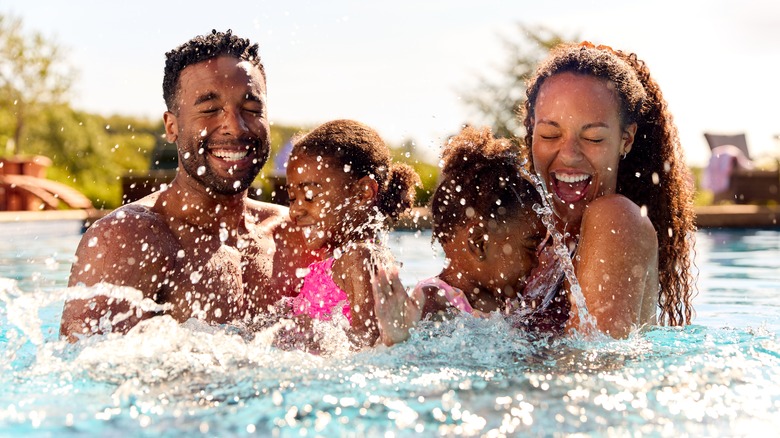These Swimsuit Colors Are Considered The Safest To Wear While Swimming
When vacation time calls, you may want to head to a beach destination like the Caribbean, visit a fun water park, or take a walk to the neighborhood pool. It also means it's important to think about safety. You may already know that it's dangerous to dig holes in the sand because they can collapse, or that you should keep an eye out for sharks, but were you aware that your bathing suit color choice could affect your safety? As it turns out, neon colors like oranges and yellows, and bright and contrasting colors like reds show up better than blues, grays, greens, and whites.
You may think that you'll be able to see your kids clearly when they're swimming, but with glare, water agitation, and distance, some colors can become difficult to detect. According to the Centers for Disease Control and Prevention (CDC), drowning is the leading cause of death for children between the ages of 1 and 4 in the United States, and it can happen very quickly. Anything that can potentially help you see your child (or an adult) in distress even a few seconds earlier could save a life.
The bathing suit experiment
It's easy for a bathing suit to disappear underwater. Glare from the sun hitting the water, movement and waves, and the color of the bottom of the pool, ocean floor or lake all play a part in how difficult it is to see through the water. In an Alive Solutions test, pictures of suits were taken under the water covering 14 different colors. Each one had a pic of the suit underwater with a calm surface, and another with the water agitated. The colors that barely showed up were white, light blue, gray, and green. You can see what the water does to blue in the TikTok below as well.
@danimorin13 Turns out swimsuits color does matter when it comes to pool safety! Stick to some neon suits this summer and keep those kiddos safe! #swimsuitsafety #swimsafety #childsafety #summersafetytips
The ones that really stood out were the reds, neon pinks (in the pool), yellows, and oranges — though it's interesting to note that in the lake test from Alive Solutions, neon pink didn't do as well. Darker colors like browns and dark blues and blacks showed up, but it was noted in the post that they can look like leaves and debris on the bottom of the pool or lake. Bernard Fisher, director of health and safety for the American Lifeguard Association told CNN that color can help parents and lifeguards spot a child faster. Fisher said, "We recommend bright and contrasting colors such as neon yellow, orange, pink, and bright red. These colors are highly visible both underwater and on the surface." However, there are other steps you can take to help keep kids and adults safe in the water.
Prevention tips and ways to recognize the signs of drowning
The CDC said that more than 4,500 people drowned in the U.S. each year between 2020 and 2022 and that 40 million adults don't know how to swim. That's something you should ensure both you and your child know how to do. The American Red Cross can help you find swimming lessons in your area. Another place to look is your local YMCA, or you can ask around at community groups in your area. You should learn CPR, which the American Red Cross can also help with. If someone like a grandparent or babysitter is watching your kids, make sure they know all of these skills as well.
Spotting the person in distress is important, and drowning may not look the way you think it does. Watch for glassy eyes and hair over the face, a blank look, or someone moving as though they are trying to climb a ladder. You may also notice someone floating or treading water, hyperventilating or gasping (not calling for help), trying to roll onto their back, or bobbing up and down. What you're unlikely to see is waving arms. Again, drowning can happen in seconds, so keep an eye on your children.
In addition to picking the right swimsuit, learning to swim, and knowing CPR, it's a good idea to only swim where there are lifeguards. Don't risk a swim in yellow flag or red flag conditions. Take a picture of your kid before you leave so you can accurately describe them if they're missing.


